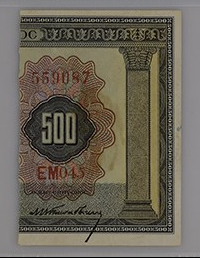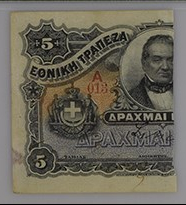
PREV ARTICLE
NEXT ARTICLE
FULL ISSUE
PREV FULL ISSUE
THE GREEK HALF-DRACHMAI BANKNOTEI missed this PMG blog post when it was published February 19, 2019. Thanks to the March 5, 2019 issue of News & Notes from the Society of Paper Money Collectors (SPMC) for bringing it to my attention. Here's an excerpt - seethe complete article online for more. -Editor
Greek notes that were cut in half helped stave off government collapse during economic turmoil.
For this month's article, we are going to explore why some of these notes were cut in half, and how they helped Greece's government avoid total collapse despite economic troubles. The economic depression led to a much-higher demand for smaller bills (the 10 drachmai being the smallest denomination available at the time).
The economic depression of the 1920s affected many nations around the globe, including Greece. In 1922, the Greek government issued a forced loan in order to finance their growing budget deficit. On April 1, 1922, the government decreed that half of all bank notes had to be surrendered and exchanged for 6.5% bonds. The notes (see figure 2) were then cut in half, with the portion bearing the Greek crown (see figure 3) standing in for the bonds while the other half was exchanged for a new issue of central bank notes at half the original value. The forced loan raised 1.6 billion drachmai, or roughly the size of the deficit. The half-drachmai trick once again proved to be only a temporary fix and the economy continued to flounder. To read the complete article, see:
THE BOOK BAZARRE
Wayne Homren, Editor The Numismatic Bibliomania Society is a non-profit organization promoting numismatic literature. See our web site at coinbooks.org. To submit items for publication in The E-Sylum, write to the Editor at this address: whomren@gmail.com To subscribe go to: https://my.binhost.com/lists/listinfo/esylum All Rights Reserved. NBS Home Page Contact the NBS webmaster 
|

